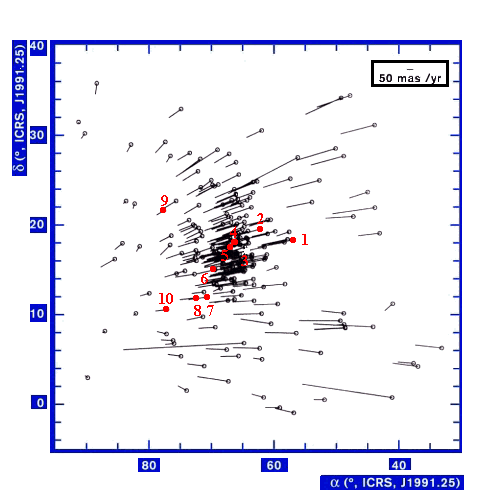The Distance to the Hyades Cluster

Table 1: Data and Distance for the 10 Marked Stars
Star Number
on Fig. 4 |
Radial Velocity
(km/sec) |
Angle q |
Transverse
Velocity
(km/sec)
| Proper Motion
(arcsec/year) |
Distance (parsecs) |
| 1 |
31.6 |
|
|
0.151 |
|
| 2 |
31.0 |
|
|
0.121 |
|
| 3 |
36.6 |
|
|
0.124 |
|
| 4 |
38.3 |
|
|
0.114 |
|
| 5 |
43.8 |
|
|
0.120 |
|
| 6 |
38.2 |
|
|
0.098 |
|
| 7 |
39.3 |
|
|
0.100 |
|
| 8 |
38.6 |
|
|
0.108 |
|
| 9 |
43.6 |
|
|
0.079 |
|
| 10 |
38.8 |
|
|
0.065 |
|
| | Average
Distance:
|
| | Error in
Distance: |
- Give two reasons why distances to individual stars vary from each other.
- Could the distance to the Hyades be determined by annual parallax? Discuss.
- Using criteria of your choice, what is the diameter of the Hyades in parsecs?
- What is the mean distance in light years to the Hyades? What is the diameter of the Hyades in light years?
- The Hipparcos satellite was able to measure the parallaxes of 200 Hyades stars very reliably. The distance to the Hyades's center of mass has been pinpointed at 46.34 +/- 0.27 parsecs, or 151 +/- 0.9 light years.
- Compare your (albeit crude) results to the Hipparcos results.
- Why is it significant that Hipparcos has parallaxes for so many stars?
- What implication does this more accurate (and precise) measurement of the distance to the Hyades have for the size of the Universe?


